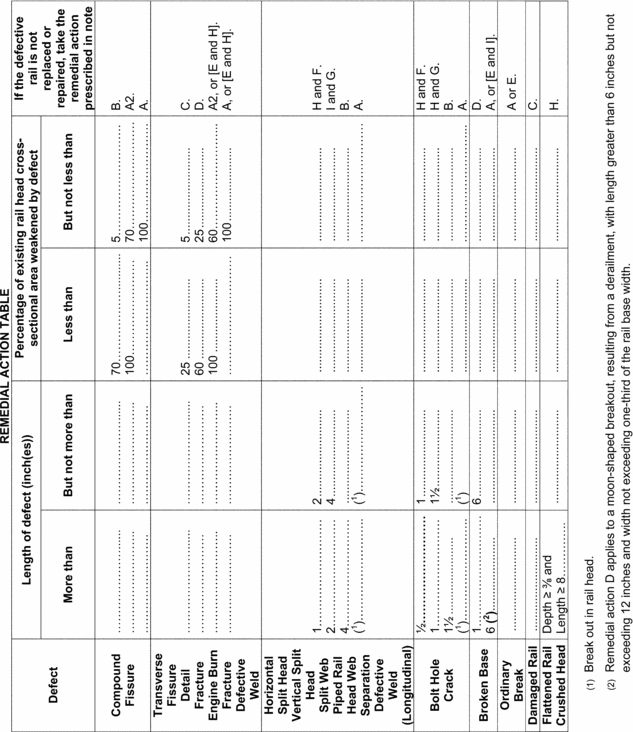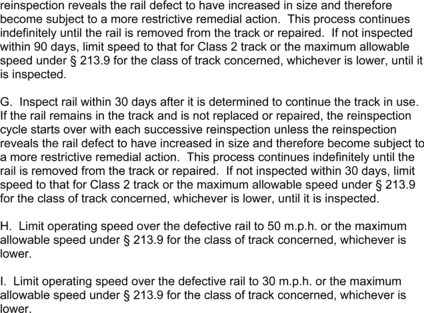Title 49
SECTION 213.113
213.113 Defective rails.
§ 213.113 Defective rails.(a) When an owner of track learns that a rail in the track contains any of the defects listed in the table contained in paragraph (c) of this section, a person designated under § 213.7 shall determine whether the track may continue in use. If the designated person determines that the track may continue in use, operation over the defective rail is not permitted until -
(1) The rail is replaced or repaired; or
(2) The remedial action prescribed in the table contained in paragraph (c) of this section is initiated.
(b) When an owner of track learns that a rail in the track contains an indication of any of the defects listed in the table contained in paragraph (c) of this section, the track owner shall verify the indication. Except as provided in § 213.240, the track owner must verify the indication within four hours, unless the track owner has an indication of the existence of a defect that requires remedial action A, A2, or B identified in the table contained in paragraph (c) of this section, in which case the track owner must immediately verify the indication. If the indication is verified, the track owner must -
(1) Replace or repair the rail; or
(2) Initiate the remedial action prescribed in the table contained in paragraph (c) of this section.
(c) A track owner who learns that a rail contains one of the following defects shall prescribe the remedial action specified if the rail is not replaced or repaired, in accordance with this paragraph's table:



(d) As used in this section -
(1) Bolt hole crack means a crack across the web, originating from a bolt hole, and progressing on a path either inclined upward toward the rail head or inclined downward toward the base. Fully developed bolt hole cracks may continue horizontally along the head/web or base/web fillet, or they may progress into and through the head or base to separate a piece of the rail end from the rail. Multiple cracks occurring in one rail end are considered to be a single defect. However, bolt hole cracks occurring in adjacent rail ends within the same joint must be reported as separate defects.
(2) Broken base means any break in the base of the rail.
(3) Compound fissure means a progressive fracture originating from a horizontal split head that turns up or down, or in both directions, in the head of the rail. Transverse development normally progresses substantially at a right angle to the length of the rail.
(4) Crushed head means a short length of rail, not at a joint, which has drooped or sagged across the width of the rail head to a depth of 3/8 inch or more below the rest of the rail head and 8 inches or more in length. Unlike flattened rail where the depression is visible on the rail head only, the sagging or drooping is also visible in the head/web fillet area.
(5) Damaged rail means any rail broken or otherwise damaged by a derailment, broken, flat, or unbalanced wheel, wheel slipping, or similar causes.
(6) Defective weld means a field or plant weld containing any discontinuities or pockets, exceeding 5 percent of the rail head area individually or 10 percent in the aggregate, oriented in or near the transverse plane, due to incomplete penetration of the weld metal between the rail ends, lack of fusion between weld and rail end metal, entrainment of slag or sand, under-bead or shrinkage cracking, or fatigue cracking. Weld defects may originate in the rail head, web, or base, and in some cases, cracks may progress from the defect into either or both adjoining rail ends. If the weld defect progresses longitudinally through the weld section, the defect is considered a split web for purposes of remedial action required by this section.
(7) Detail fracture means a progressive fracture originating at or near the surface of the rail head. These fractures should not be confused with transverse fissures, compound fissures, or other defects which have internal origins. Detail fractures may arise from shelled spots, head checks, or flaking.
(8) Engine burn fracture means a progressive fracture originating in spots where driving wheels have slipped on top of the rail head. In developing downward these fractures frequently resemble the compound or even transverse fissures with which they should not be confused or classified.
(9) Flattened rail means a short length of rail, not at a joint, which has flattened out across the width of the rail head to a depth of 3/8 inch or more below the rest of the rail and 8 inches or more in length. Flattened rail occurrences have no repetitive regularity and thus do not include corrugations, and have no apparent localized cause such as a weld or engine burn. Their individual length is relatively short, as compared to a condition such as head flow on the low rail of curves.
(10) Head and web separation means a progressive fracture, longitudinally separating the head from the web of the rail at the head fillet area.
(11) Horizontal split head means a horizontal progressive defect originating inside of the rail head, usually 1/4 inch or more below the running surface and progressing horizontally in all directions, and generally accompanied by a flat spot on the running surface. The defect appears as a crack lengthwise of the rail when it reaches the side of the rail head.
(12) Ordinary break means a partial or complete break in which there is no sign of a fissure, and in which none of the other defects described in this paragraph (d) is found.
(13) Piped rail means a vertical split in a rail, usually in the web, due to failure of the shrinkage cavity in the ingot to unite in rolling.
(14) Split web means a lengthwise crack along the side of the web and extending into or through it.
(15) Transverse fissure means a progressive crosswise fracture starting from a crystalline center or nucleus inside the head from which it spreads outward as a smooth, bright, or dark round or oval surface substantially at a right angle to the length of the rail. The distinguishing features of a transverse fissure from other types of fractures or defects are the crystalline center or nucleus and the nearly smooth surface of the development which surrounds it.
(16) Vertical split head means a vertical split through or near the middle of the head, and extending into or through it. A crack or rust streak may show under the head close to the web or pieces may be split off the side of the head.
[79 FR 4256, Jan. 24, 2014; 79 FR 4633, Jan. 29, 2014, as amended at 85 FR 63388, Oct. 7, 2020]